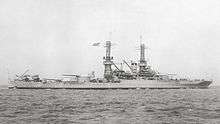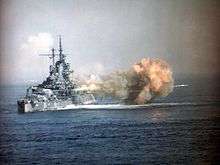USS Idaho (BB-42)
_at_1927_naval_review.jpg) USS Idaho (BB-42) in 1927. | |
| History | |
|---|---|
| Name: | Idaho |
| Namesake: | Idaho |
| Awarded: | 30 June 1914 |
| Builder: | New York Shipbuilding Corporation |
| Laid down: | 20 January 1915 |
| Launched: | 30 June 1917 |
| Sponsored by: | Henrietta Amelia Simmons |
| Commissioned: | 24 March 1919 |
| Decommissioned: | 3 July 1946 |
| Identification: |
|
| Nickname(s): | "Big Spud" |
| Honors and awards: | 7 × battle stars |
| Fate: | Sold 24 November 1947 |
| Status: | Scrapped in Newark, NJ, 1947–48 |
| General characteristics [1] | |
| Class and type: | New Mexico-class battleship |
| Displacement: | 32,000 long tons (32,514 t) |
| Length: | 624 ft (190 m) |
| Beam: | 97 ft 5 in (29.69 m) |
| Draft: | 30 ft (9.1 m) |
| Installed power: | 32,000 shp (24,000 kW) |
| Propulsion: | |
| Speed: | 21 kn (24 mph; 39 km/h) |
| Complement: | 1,081 officers and men |
| Armament: | |
| Armor: |
|
USS Idaho (BB-42), a New Mexico-class battleship, was the fourth ship of the United States Navy to be named for the 43rd state. Her keel was laid down by the New York Shipbuilding Corporation of Camden, New Jersey. She was launched on 30 June 1917 sponsored by Miss Henrietta Amelia Simons, granddaughter of Idaho Governor Moses Alexander; and commissioned on 24 March 1919, Captain Carl Theodore Vogelgesang in command.
Inter-War period

Idaho sailed on 13 April 1919 for shakedown training out of Guantanamo Bay, and after returning to New York City received President of Brazil Epitácio Pessoa for the voyage to Rio de Janeiro. Departing on 6 July with her escort, the battleship arrived Rio on 17 July. From there she set course for the Panama Canal, arriving Monterey, California, in September to join the Pacific Fleet. She joined other dreadnoughts in training exercises and reviews, including a Fleet Review by President of the United States Woodrow Wilson on 13 September. In 1920, the battleship carried Secretary of the Navy Josephus Daniels and the Secretary of the Interior John B. Payne on an inspection tour of Alaska.
Upon her return from Alaska on 22 July 1920, Idaho took part in fleet maneuvers off the California coast and as far south as Chile. She continued this training until 1925, taking part in numerous ceremonies on the West Coast during the interim. Two of the original 14 5-inch (127 mm)/51 cal guns were removed in 1922.[2] Idaho took part in the fleet review held by President Warren Harding in Seattle shortly before his death in 1923. The battleship sailed on 15 April 1925 for Hawaii, participated in war games until 1 July, and then got underway for Samoa, Australia, and New Zealand. On the return voyage, Idaho embarked gallant Commander John Rodgers and his seaplane crew after their attempt to fly to Hawaii, arriving San Francisco, California on 24 September.
For the next six years, Idaho operated out of San Pedro, California, on training and readiness operations off California and in the Caribbean Sea. She sailed from San Pedro on 7 September 1931 for the East Coast, entering Norfolk Navy Yard on 30 September for modernization. The earlier 3-inch (76 mm)/50 caliber anti-aircraft guns were replaced by eight 5-inch (127 mm)/25 cal guns.[2] The veteran battleship also received better armor, "blister" antisubmarine protection, better machinery, and tower masts during this extensive overhaul, and was readied for many more years of useful naval service. After completion on 9 October 1934, the ship conducted shakedown in the Caribbean before returning to her home port, San Pedro on 17 April 1935.
As war clouds gathered in the Pacific, the fleet increased the tempo of its training operations. Idaho carried out fleet tactics and gunnery exercises regularly until arriving with the battle fleet at Pearl Harbor on 1 July 1940. The ship sailed for Hampton Roads on 6 June 1941 to perform Atlantic neutrality patrol, a vital part of US policy in the early days of the European fighting. She moved to Iceland in September to protect American advance bases and was on station at Hvalfjörður when the Japanese attack on Pearl Harbor on 7 December catapulted America into the war.
World War II

Idaho and sister ship Mississippi departed Iceland two days after Pearl Harbor to join the Pacific Fleet, and arrived at San Francisco, California, via Norfolk, Virginia, and the Panama Canal on 31 January 1942. She conducted additional battle exercises in California waters and out of Pearl Harbor until October 1942, when she entered Puget Sound Navy Yard to be regunned. The original secondary battery of 5-inch (127 mm)/51 cal. guns was removed to make room for anti-aircraft machine guns.[2] Upon completion of this work, Idaho again took part in battle exercises, and sailed on 7 April 1943 for operations in the Aleutian Islands. There she was flagship of the bombardment and patrol force around Attu, where she gave gunfire support to the United States Army landings on 11 May. During the months that followed, she concentrated on Kiska, culminating in an assault on 15 August. The Japanese were found to have evacuated the island in late July, thus abandoning their last foothold in the Aleutians.
Idaho returned to San Francisco on 7 September to prepare for the invasion of the Gilbert Islands. Moving to Pearl Harbor, she got underway with the assault fleet on 10 November and arrived off Makin Atoll on 20 November. She supported the fighting ashore with accurate gunfire support and antiaircraft fire, remaining in the Gilberts until sailing for Pearl Harbor on 5 December.
Next on the Pacific timetable was the invasion of the Marshall Islands, and the veteran battleship arrived off Kwajalein early on 31 January 1944 to soften up shore positions. Again, she hurled tons of shells into Japanese positions until 5 February, when the outcome was one of certain victory. After replenishing at Majuro, she bombarded other islands in the group, then moved to Kavieng, New Ireland for a diversionary bombardment on 20 March.

Idaho returned to the New Hebrides on 25 March, and after a short stay in Australia arrived Kwajalein with a group of escort carriers on 8 June. From there, the ships steamed to the Marianas, where Idaho began a pre-invasion bombardment of Saipan on 14 June. With the landing assault underway on 15 June, the battleship moved to Guam for bombardment assignments. As the American fleet destroyed Japanese carrier air power in the Battle of the Philippine Sea from 19–21 June, Idaho protected the precious transport area and reserve convoys. After returning to Eniwetok from 28 June to 9 July, the ship began preinvasion bombardment of Guam on 12 July, and continued the devastating shelling until the main assault eight days later. As ground troops battled for the island, Idaho stood offshore providing vital support until anchoring at Eniwetok on 2 August.
The ship continued to Espiritu Santo and entered a floating dry dock on 15 August for repairs to her "blisters". After landing rehearsals on Guadalcanal in early September, Idaho moved to Peleliu on 12 September and began bombarding the island, needed as a staging base for the invasion of the Philippines. Despite the furious bombardment, Japanese entrenchments gave assault forces stiff opposition, and the battleship remained off Peleliu until 24 September providing the all-important fire support for advancing Marines. She then sailed for Manus and eventually to Bremerton, Washington, where she arrived for needed repairs on 22 October. The 5-inch (127 mm)/25 cal guns were replaced by 10 5-inch (127 mm)/38 cal guns in single enclosed mounts (she was the only ship of her class to receive this modification).[2] This was followed by battle practice off California.
Idaho's mighty guns were needed for the next giant amphibious assault on the way to Japan. She sailed from San Diego on 20 January 1945 to join a battleship group at Pearl Harbor. After rehearsals, she steamed from the Marianas on 14 February for the invasion of Iwo Jima. As Marines stormed ashore on 19 February, Idaho was again blasting enemy positions with her big guns, and fired star shells at night to illuminate the battlefield. She remained off Iwo Jima until 7 March, when she underway for Ulithi and the last of the great Pacific assaults – Okinawa.
Idaho sailed on 21 March as part of Rear Admiral Deyo's Gunfire and Covering Group and flagship of Bombardment Unit 4. She arrived offshore on 25 March and began silencing enemy shore batteries and pounding installations. The landings began on 1 April, and as the Japanese made a desperate attempt to drive the vast fleet away with kamikaze attacks, Idaho's gunners shot down numerous planes. In a massed attack on 12 April, the battleship shot down five kamikazes before suffering damage to her port blisters from a near-miss. After temporary repairs, she sailed 20 April and arrived at Guam five days later.
The veteran of so many of the landings of the Pacific quickly completed repairs and returned to Okinawa on 22 May to resume fire support. Idaho remained until 20 June, then sailed for battle maneuvers in Leyte Gulf until hostilities ceased on 15 August.
Idaho made her triumphal entry into Tokyo Bay with occupation troops on 27 August, and was anchored there during the signing of the surrender on board Missouri on 2 September. Four days later she began the long voyage to the East Coast of the United States, steaming via the Panama Canal to arrive at Norfolk on 16 October. She decommissioned on 3 July 1946 and was placed in reserve until sold for scrap on 24 November 1947 to Lipsett, Incorporated, of New York City.
Awards
- American Defense Service Medal with "FLEET" clasp
- European-African-Middle Eastern Campaign Medal
- American Campaign Medal
- Asiatic-Pacific Campaign Medal with seven battle stars
- World War II Victory Medal
- Navy Occupation Medal with "ASIA" clasp
Notes
- ↑ Gardiner & Gray 1985, p. 117.
- 1 2 3 4 Breyer 1973, p. 219.
References
- Breyer, Siegfried (1973). Battleships and Battle Cruisers 1905–1970. Doubleday and Company. ISBN 0-385-07247-3.
- Gardiner, Robert; Gray, Randal, eds. (1985). Conway's All the World's Fighting Ships: 1906–1921. Annapolis, Maryland: Naval Institute Press. ISBN 0-87021-907-3. OCLC 12119866.
- This article incorporates text from the public domain Dictionary of American Naval Fighting Ships. The entry can be found here.
External links
| Wikimedia Commons has media related to USS Idaho (BB-42). |
- US Navy Historical Center gallery
- MaritimeQuest USS Idaho BB-42 Photo Gallery
- General Plan for the U.S.S. Idaho (BB-42), New Mexico Class, hosted by the Historical Naval Ships Association (HNSA) Digital Collections
- From Dam Neck to Okinawa, First person account of Kamikazee attacks on Idaho and Tennessee by an Anti-Aircraft Director
- Photo gallery of USS Idaho (BB-42) at NavSource Naval History